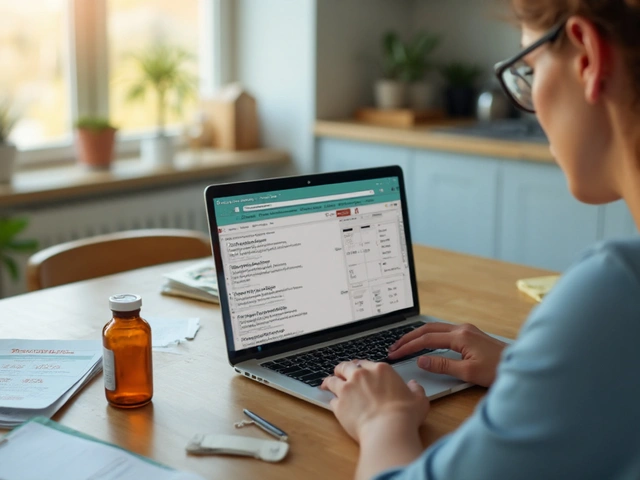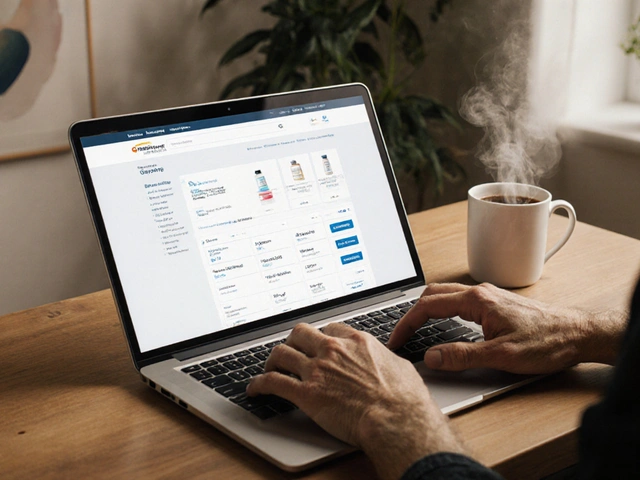Iron-Folic Acid Supplement Checker
Check Your Supplement
Pregnancy feels like a marathon you run with a tiny teammate on your back. You want every step to be steady, every mile safe. That’s why iron folic acid pregnancy health is a conversation you’ll hear a lot at prenatal visits. In this guide we’ll unpack what an Iron‑Folic Acid supplement actually does, why it’s a must‑have for most expectant moms, and how to use it without the usual headaches.
What is an Iron‑Folic Acid supplement?
Iron‑Folic Acid Supplement is a combined tablet that delivers two key nutrients-elemental iron and folic acid-at doses the World Health Organization says are safe for pregnant women. The iron component (usually ferrous sulfate) helps build red blood cells, while the folic acid (synthetic form of vitamin B9) supports cell division and DNA synthesis.
These tablets are often marketed as “IFA tablets” or “iron‑folic tablets.” The convenience of a single pill means you don’t have to remember separate iron and folic acid bottles, which cuts down on missed doses.
Why the extra iron?
Iron deficiency anemia is the most common nutritional deficiency worldwide, and pregnant women are especially vulnerable. As a fetus grows, it needs more oxygen, and your blood has to carry that oxygen via hemoglobin. Without enough iron, hemoglobin levels drop, leading to fatigue, shortness of breath, and a higher risk of preterm birth.
Studies from the WHO show that up to 40% of pregnant women in low‑income settings develop anemia. Even in high‑income countries, the figure hovers around 15‑20% when diet alone can’t keep up with the increased demand.
Iron also plays a role in immune function, so low iron can make moms more susceptible to infections that could affect the baby.
The folic acid factor
Folic acid is the synthetic counterpart of the natural vitamin B9 found in leafy greens, beans, and citrus. Its most celebrated job is preventing Neural tube defects, serious birth defects of the brain and spine such as spina bifida and anencephaly.
The neural tube closes by the fourth week of pregnancy, often before a woman even knows she’s pregnant. That’s why public‑health campaigns push for a daily 400 µg dose of folic acid for all women of childbearing age, and 600 µg once pregnancy is confirmed.
Beyond the neural tube, folic acid supports the rapid cell division needed for placenta growth and fetal organ development. Low folate levels have been linked to low birth weight and even maternal depression postpartum.
How much is enough? WHO guidelines and daily recommendations
The World Health Organization (WHO) recommends a daily supplement containing 30-60 mg of elemental iron and 400 µg (0.4 mg) of folic acid for pregnant women in areas where anemia is a public health concern. In many high‑income countries, the standard prenatal IFA tablet provides 27 mg of iron and 500 µg of folic acid, aligning closely with these guidelines.
It’s important to note that iron supplements can cause gastrointestinal upset. The WHO suggests taking the tablet with food or a glass of orange juice to improve absorption (thanks to vitamin C) and reduce nausea.
For women with severe anemia, doctors may prescribe higher‑dose iron (up to 120 mg) but usually for a short period, followed by the maintenance IFA dose.
IFA vs. other prenatal options - a quick side‑by‑side look
| Supplement Type | Iron (mg) | Folic Acid (µg) | Other Key Nutrients | Typical Use Case |
|---|---|---|---|---|
| Iron‑Folic Acid (IFA) | 27-30 | 400-500 | Vitamin C, Zinc (small amounts) | Standard for most pregnancies, especially in anemia‑prevalent regions |
| Iron‑only supplement | 60-120 | 0 | None | Severe anemia cases, prescribed by doctor |
| Folic‑only supplement | 0 | 400-800 | Vitamin B12 (sometimes) | Pre‑conception or early pregnancy when iron is adequate |
| Standard prenatal vitamin | 15-18 | 600-800 | Calcium, Vitamin D, DHA, Iodine | General nutrition, often combined with separate iron if needed |
Notice how the IFA tablet balances iron and folic acid without flooding the diet with excess. Adding a standard prenatal vitamin on top of IFA is common, but you should watch the total iron content to avoid overload.

Practical tips for taking IFA safely
- Take the tablet with a glass of orange juice or a vitamin C‑rich snack. Vitamin C boosts iron absorption by up to 70%.
- If you experience constipation, increase water intake, add fiber‑rich foods, or consider a stool softener after consulting your provider.
- Separate iron from calcium‑rich foods (milk, cheese) by at least two hours. Calcium competes with iron for absorption.
- Watch for nausea. Splitting the dose-half in the morning, half in the evening-can help, but keep each half with food.
- Check your Hemoglobin level around 12 weeks and again at 28 weeks. Your doctor will adjust the dose if needed.
Most side effects are mild and disappear after a few weeks as your body gets used to the supplement.
Common myths busted
Myth 1: I can get enough iron from meat alone. Even meat‑eaters often fall short because pregnancy raises iron needs by 50% compared to non‑pregnant adults.
Myth 2: Folic acid is only important in the first month. While the neural tube closes early, folate continues to aid DNA synthesis throughout pregnancy, supporting placental growth and preventing other birth defects.
Myth 3: More iron is always better. Excess iron can cause oxidative stress and gastrointestinal distress. Stick to the recommended dose unless a doctor orders more.
Frequently Asked Questions
Can I take IFA with my prenatal vitamin?
Yes, most doctors recommend a standard prenatal vitamin in addition to IFA, but watch the total iron amount. If your prenatal vitamin already has 15 mg of iron, you might get 40‑45 mg total, which is still within safe limits for most women.
What should I do if I forget a dose?
Take it as soon as you remember, unless it’s almost time for the next dose. Then skip the missed one and continue with your regular schedule. Doubling up can increase nausea and constipation.
Are there any foods I should avoid while on IFA?
High‑phytate foods (like raw beans and whole‑grain bread) can bind iron and lower absorption. Soaking, sprouting, or cooking these foods reduces the effect. Also limit tea and coffee around supplement time because tannins inhibit iron uptake.
Is IFA safe for women with gestational diabetes?
Yes. Iron and folic acid don’t impact blood glucose directly. However, keep an eye on overall calories and carbs in your diet. Discuss any supplement changes with your endocrinologist.
Can I switch to a natural folate source instead of folic acid?
Methyl‑folate (the active form) is available, but most guidelines still favor folic acid because its absorption is well‑studied. If you have a known MTHFR mutation, discuss methyl‑folate with your provider.
Bottom line: Iron‑Folic Acid tablets are a proven, low‑cost way to protect both mom and baby from the most common nutrient gaps in pregnancy. Pair the supplement with a balanced diet, stay hydrated, and keep your prenatal appointments for blood‑work checks. With the right plan, you’ll give your baby a solid start and keep yourself feeling strong enough to enjoy every kick and hiccup along the way.






Comments
I think the iron folic thing is just hype
Hey, I get that it can feel overwhelming, but trust the science – even if it sounds like a lot. You’re not alone, many pregnant folks worry about side effects, so take it with food and stay hydrated. It’ll help you keep your energy up and protect the baby’s development. Keep it up, you’re doing great!
It is imperative to recognize that the prevalence of iron‑folic supplementation is not merely a benign public‑health recommendation but a meticulously orchestrated stratagem by pharmaceutical conglomerates to secure market dominance under the guise of maternal welfare. The World Health Organization’s dosage guidelines, while ostensibly evidence‑based, have been subtly calibrated to perpetuate a dependency on proprietary formulations rather than encouraging dietary diversification. One must remain vigilant against the insidious normalization of synthetic folic acid, which bypasses the nuanced metabolic pathways of natural folates and may harbor unforeseen epigenetic ramifications. In short, the narrative of universal supplementation warrants rigorous scrutiny beyond the superficial veneer of benevolence.
Okay, let’s break this down step by step so everyone can follow along. First, iron is absolutely essential for making hemoglobin, the protein that carries oxygen in your blood, and during pregnancy your blood volume jumps by about 50%, so the demand spikes dramatically.
Second, folic acid isn’t just a “first‑trimester thing” – it stays important throughout pregnancy because it supports rapid cell division in the placenta and fetal organs.
Third, the typical IFA tablet contains roughly 27–30 mg of elemental iron, which is enough to replenish stores without overwhelming the gut if you take it with food or a glass of orange juice (vitamin C really boosts absorption).
Fourth, timing matters: avoid dairy, calcium supplements, tea, or coffee within two hours of taking your IFA, as calcium and tannins can compete with iron for uptake.
Fifth, if you experience constipation (a common side effect), up your water intake, add fiber‑rich veggies, and consider a gentle stool softener after consulting your provider.
Sixth, monitor your hemoglobin levels at the usual prenatal checkpoints (around 12 weeks and again at 28 weeks); your clinician can adjust the dose if you’re borderline anemic or if you’ve been prescribed a higher‑dose iron regimen for a short period.
Seventh, don’t forget that the folic acid component (usually 400‑500 µg) is well‑studied for preventing neural‑tube defects, and most guidelines still favor the synthetic form for its reliable bioavailability, unless you have a known MTHFR mutation where methyl‑folate might be better.
Eighth, if you’re already taking a standard prenatal vitamin that contains iron, add up the total iron – most combos stay under 45 mg, which is safe for the majority of pregnant people.
Ninth, watch for nausea: splitting the dose (half in the morning, half in the evening) or taking it with a small snack can make a big difference.
Tenth, stay consistent – missing a few doses occasionally isn’t catastrophic, but try to maintain a regular schedule to keep iron stores stable.
Eleventh, if you suspect an interaction with any other meds (like certain antibiotics or thyroid meds), flag it with your OB‑GYN.
Twelfth, remember that iron overload is rare in pregnancy but can cause oxidative stress, so never self‑escalate the dose without medical guidance.
Thirteenth, keep an eye on any unusual fatigue or shortness of breath; those can be signs your iron is still low.
Fourteenth, maintain a balanced diet rich in leafy greens, legumes, and lean meats to complement the supplement.
Fifteenth, and finally, stay positive – the right riboflavin of iron‑folic acid support can help you feel stronger and give your baby the best start. 😊
While the preceding exposition offers a comprehensive overview, it overlooks the critical point that indiscriminate supplementation can obscure underlying dietary deficiencies. A rigorous assessment of baseline iron status is essential before instituting universal IFA therapy, lest we foster a false sense of security and ignore more nuanced nutritional interventions.